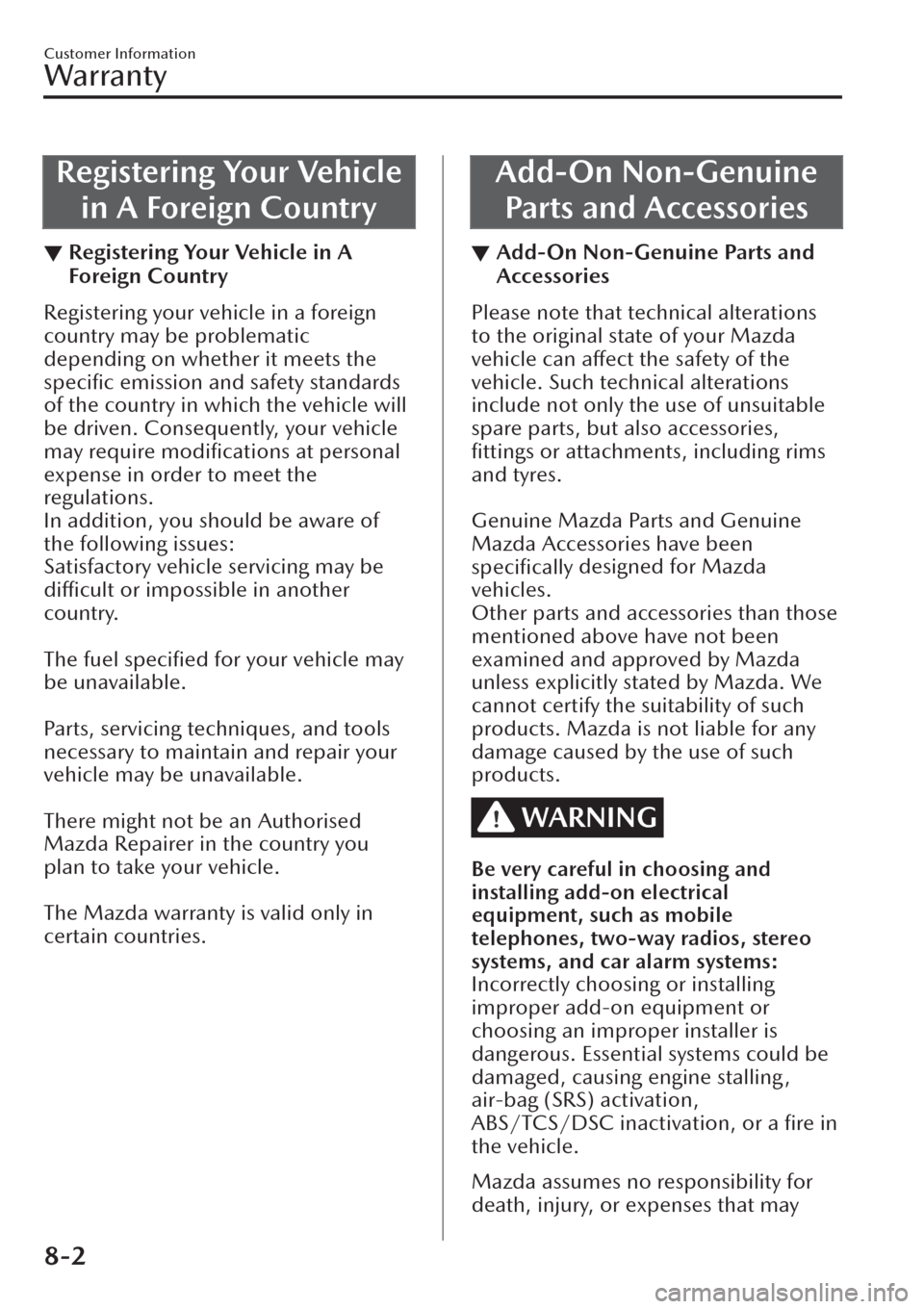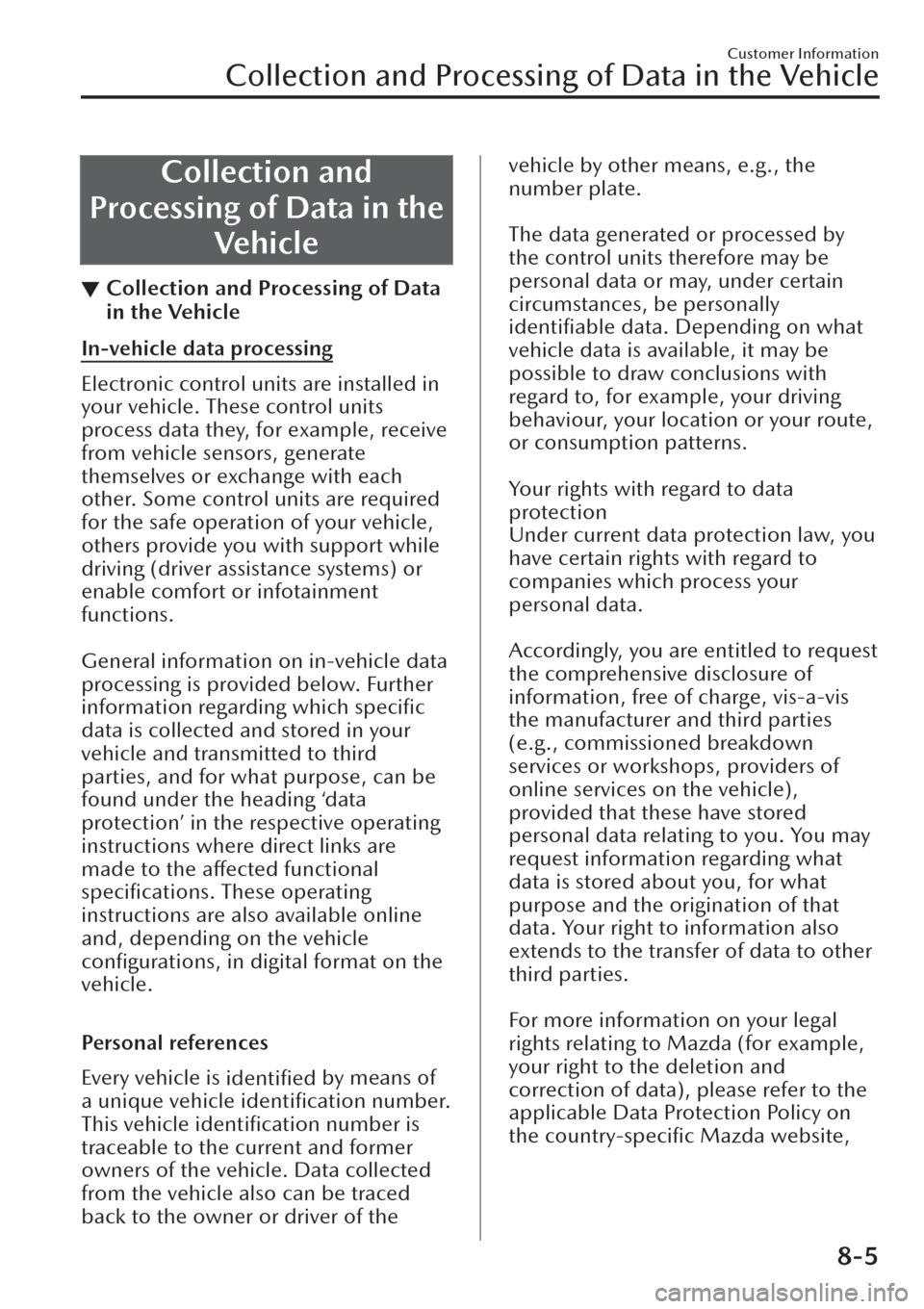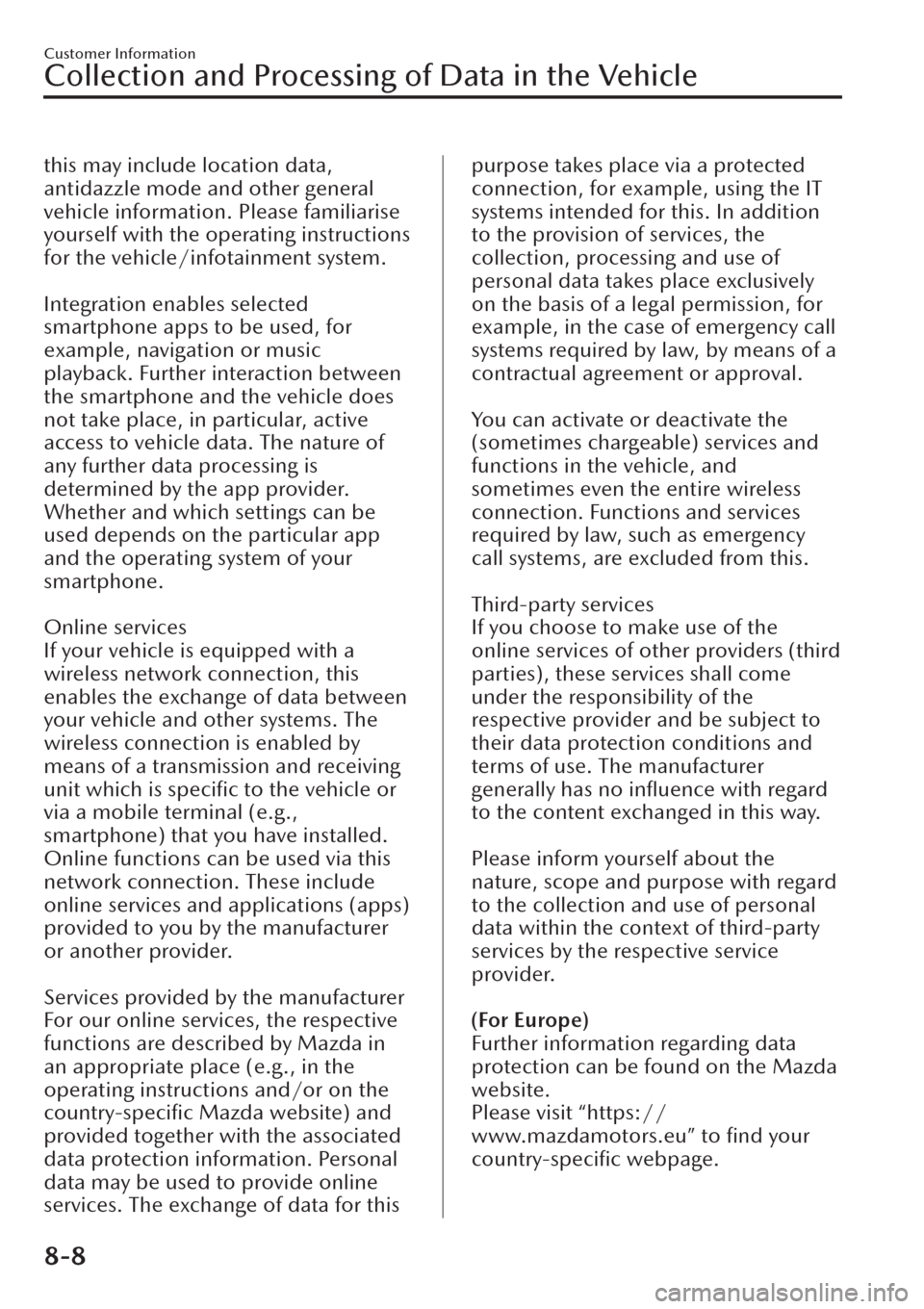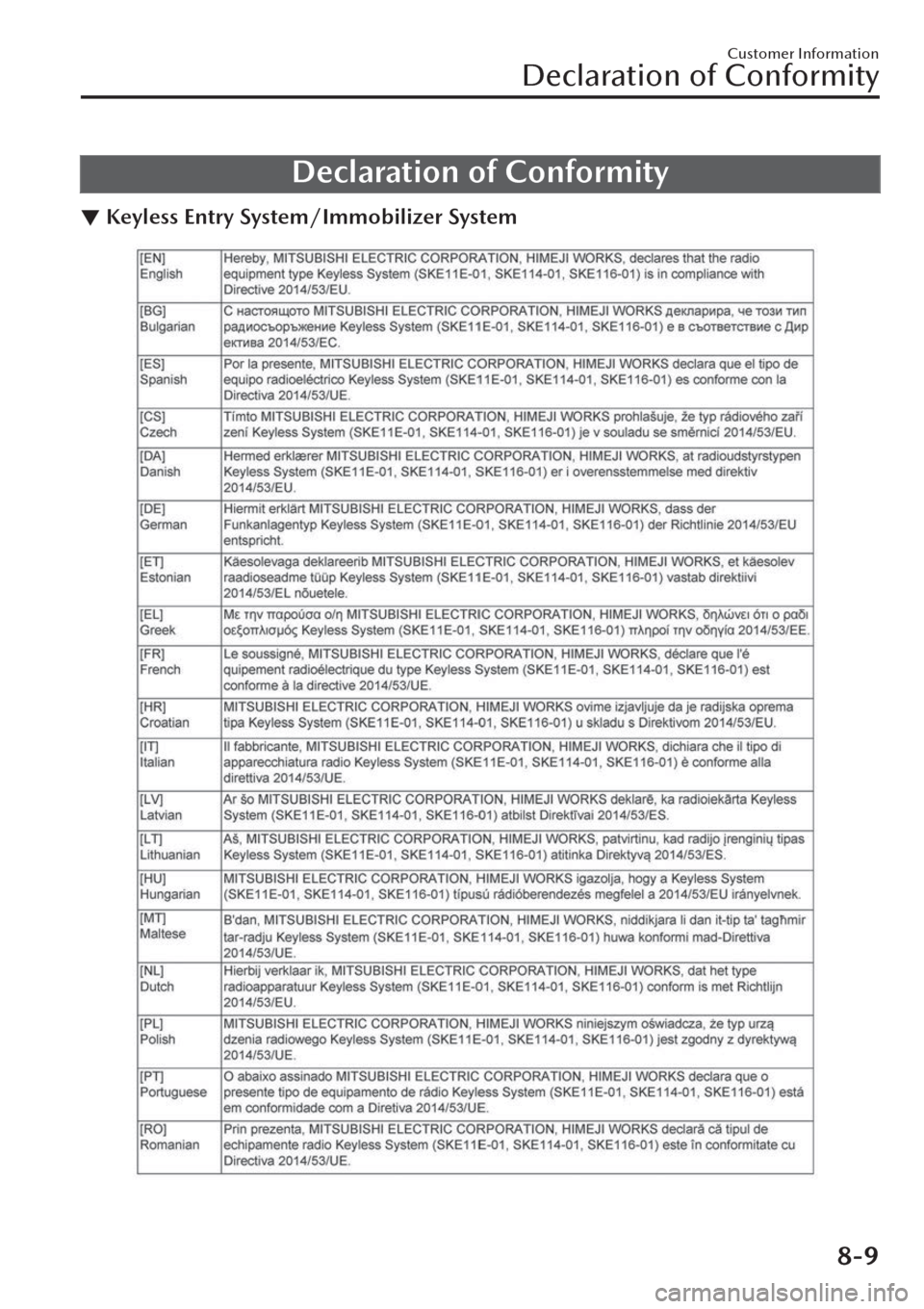MAZDA MODEL CX-30 2019 Owners Manual (in English)
Manufacturer: MAZDA, Model Year: 2019, Model line: MODEL CX-30, Model: MAZDA MODEL CX-30 2019Pages: 683, PDF Size: 15.21 MB
Page 591 of 683

8Customer Information
Important consumer information including warranties and add-
on equipment.
Warranty..................................8-2
Registering Your Vehicle in A
Foreign Country..................... 8-2
Add-On Non-Genuine Parts and
Accessories........................... 8-2
Cell Phones.............................. 8-4
Cell Phones Warning.............. 8-4
Collection and Processing of Data in
the Vehicle............................... 8-5
Collection and Processing of Data
in the Vehicle........................ 8-5
Declaration of Conformity......... 8-9
Declaration of Conformity ...........
............................................ 8-9
Electromagnetic
Compatibility......................... 8-66
Electromagnetic
Compatibility...................... 8-66
Collection/Disposal of Old
Equipment/Used Battery......... 8-68
Information for Users on
Collection and Disposal of Old
Equipment and Used
Batteries.............................. 8-68
8-1
Page 592 of 683

Registering Your Vehicle
in A Foreign Country
ā¼Registering Your Vehicle in A
Foreign Country
Registering your vehicle in a foreign
country may be problematic
depending on whether it meets the
speciļ¬c emission and safety standards
of the country in which the vehicle will
be driven. Consequently, your vehicle
may require
modiļ¬cations at personal
expense in order to meet the
regulations.
In addition, you should be aware of
the following issues:
Satisfactory vehicle servicing may be
difficult or impossible in another
country.
The fuel speciļ¬ed for your vehicle may
be unavailable.
Parts, servicing techniques, and tools
necessary to maintain and repair your
vehicle may be unavailable.
There might not be an Authorised
Mazda Repairer in the country you
plan to take your vehicle.
The Mazda warranty is valid only in
certain countries.
Add-On Non-Genuine
Parts and Accessories
ā¼Add-On Non-Genuine Parts and
Accessories
Please note that technical alterations
to the original state of your Mazda
vehicle can
affect the safety of the
vehicle. Such technical alterations
include not only the use of unsuitable
spare parts, but also accessories,
ļ¬ttings or attachments, including rims
and tyres.
Genuine Mazda Parts and Genuine
Mazda Accessories have been
speciļ¬cally designed for Mazda
vehicles.
Other parts and accessories than those
mentioned above have not been
examined and approved by Mazda
unless explicitly stated by Mazda. We
cannot certify the suitability of such
products. Mazda is not liable for any
damage caused by the use of such
products.
WARNING
Be very careful in choosing and
installing add-on electrical
equipment, such as mobile
telephones, two-way radios, stereo
systems, and car alarm systems:
Incorrectly choosing or installing
improper add-on equipment or
choosing an improper installer is
dangerous. Essential systems could be
damaged, causing engine stalling ,
air-bag (SRS) activation,
ABS/TCS/DSC inactivation, or a ļ¬re in
the vehicle.
Mazda assumes no responsibility for
death, injury, or expenses that may
Customer Information
Warranty
8-2
Page 593 of 683

result from the installation of add-on
non-genuine parts or accessories.
Customer Information
Warranty
8-3
Page 594 of 683

Cell Phones Warning
ā¼Cell Phones Warning
WARNING
Please comply with the legal
regulations concerning the use of
communication equipment in vehicles
in your country:
Use of any electrical devices such as
cell phones, computers, portable
radios, vehicle navigation or other
devices by the driver while the vehicle
is moving is dangerous. Dialing a
number on a cell phone while driving
also ties-up the driver's hands. Use of
these devices will cause the driver to
be distracted and could lead to a
serious accident. If a passenger is
unable to use the device, pull
off the
right-of-way to a safe area before use.
If use of a cell phone is necessary
despite this warning, use a hands-free
system to at least leave the hands free
to drive the vehicle. Never use a cell
phone or other electrical devices while
the vehicle is moving and, instead,
concentrate on the full-time job of
driving.
Customer Information
Cell Phones
8-4
Page 595 of 683

Collection and
Processing of Data in the
Ve h i c l e
ā¼Collection and Processing of Data
in the Vehicle
In-vehicle data processing
Electronic control units are installed in
your vehicle. These control units
process data they, for example, receive
from vehicle sensors, generate
themselves or exchange with each
other. Some control units are required
for the safe operation of your vehicle,
others provide you with support while
driving (driver assistance systems) or
enable comfort or infotainment
functions.
General information on in-vehicle data
processing is provided below. Further
information regarding which speciļ¬c
data is collected and stored in your
vehicle and transmitted to third
parties, and for what purpose, can be
found under the heading ādata
protectionā in the respective operating
instructions where direct links are
made to the affected functional
speciļ¬cations. These operating
instructions are also available online
and, depending on the vehicle
conļ¬gurations, in digital format on the
vehicle.
Personal references
Every vehicle is
identiļ¬ed by means of
a unique vehicle identiļ¬cation number.
This vehicle
identiļ¬cation number is
traceable to the current and former
owners of the vehicle. Data collected
from the vehicle also can be traced
back to the owner or driver of the
vehicle by other means, e.g., the
number plate.
The data generated or processed by
the control units therefore may be
personal data or may, under certain
circumstances, be personally
identiļ¬able data. Depending on what
vehicle data is available, it may be
possible to draw conclusions with
regard to, for example, your driving
behaviour, your location or your route,
or consumption patterns.
Your rights with regard to data
protection
Under current data protection law, you
have certain rights with regard to
companies which process your
personal data.
Accordingly, you are entitled to request
the comprehensive disclosure of
information, free of charge, vis-a-vis
the manufacturer and third parties
(e.g., commissioned breakdown
services or workshops, providers of
online services on the vehicle),
provided that these have stored
personal data relating to you. You may
request information regarding what
data is stored about you, for what
purpose and the origination of that
data. Your right to information also
extends to the transfer of data to other
third parties.
For more information on your legal
rights relating to Mazda (for example,
your right to the deletion and
correction of data), please refer to the
applicable Data Protection Policy on
the country-speciļ¬c Mazda website,
Customer Information
Collection and Processing of Data in the Vehicle
8-5
Page 596 of 683

where contact details are also
provided.
Data, which is exclusively stored locally
on the vehicle, may be viewed with
expert assistance, e.g., in a vehicle
workshop, in return for payment if
appropriate.
Legal requirements regarding the
disclosure of data
To the extent that legal regulations
exist, manufacturers are obliged to
release information stored by them, at
the request of public authorities, to the
extent required on a case-by-case
basis (e.g., when a criminal offence is
being investigated).
Public authorities are also permitted to
read the data from vehicles in speciļ¬c
cases, within the scope of applicable
law. For example, in the event of an
accident, information can be read from
the air bag control unit to help clarify
the circumstances of the accident.
Operational data on the vehicle
Control units process data in order to
operate the vehicle.
These include, for example:
�xvehicle status information (e.g.,
speed, deceleration, lateral
acceleration, wheel speed, seatbelt
usage indicator),
�xenvironmental conditions (e.g.,
temperature, rain sensor, distance
sensor).
These data are generally volatile and
are not stored beyond the operating
time, and only processed on the
vehicle itself. Control units frequently
contain data storage media. These can
be used to document, either
temporarily or permanently,
information about the condition of the
vehicle, component stress,
maintenance requirements and
technical events and failures.
The following information may be
stored, depending on the technical
conļ¬guration:
�xoperating conditions of system
components (e.g.,
ļ¬ll levels, tyre
pressures and battery status),
�xmalfunctions and defects in
important system components (e.g.,
lighting and brakes),
�xresponse of the system to
extraordinary driving situations (e.g.,
deployment of an air bag, activation
of stability control systems),
�xinformation on events in which the
vehicle is damaged,
�xfor electric vehicles, the state of
charge of the high-voltage battery
and the vehicleās estimated range.
In particular cases (e.g., if the vehicle
has detected a malfunction), it may be
necessary to store data which would
normally be volatile.
If you make use of services (e.g., repair
and maintenance services), it may be
possible, if necessary, to read out and
use the stored operating data together
with the vehicle identiļ¬cation number.
The data from the vehicle may be read
out by employees of the Mazda
Network (e.g. authorised workshops,
manufacturer) or by third parties (e.g.,
breakdown services, independent
repair shops). The same applies in the
case of warranty cases and quality
assurance measures.
The data is usually read out via the
mandatory OBD (on-board
Customer Information
Collection and Processing of Data in the Vehicle
8-6
Page 597 of 683

diagnostics) connection on the vehicle.
The operating data read out document
the technical conditions of the vehicle
or individual components and help
with fault diagnostics, compliance with
warranty obligations and quality
improvement. These data, in particular
information regarding component
stress, technical events, operating
errors and other errors are transmitted
to the manufacturer, if necessary,
together with the vehicle identiļ¬cation
number. In addition, product liability
falls under the responsibility of the
manufacturer. For this purpose, the
manufacturer uses operating data
external to the vehicles, for example,
recall campaigns. These data also may
be used to verify the customerās
statutory warranty and manufacturer
warranty claims.
Error memory on the vehicle can be
reset by a service operator within the
course of repair and maintenance work
or at your request.
Comfort and infotainment functions
You can store comfort settings and
customisations on the vehicle, and
change/reset these at any time.
Depending on the particular vehicle
conļ¬gurations, these may include:
�xseat and steering wheel position
settings,
�xchassis adjustments and
air-conditioning settings,
�xcustomisations such as interior
lighting.
You are also able to incorporate data
into the vehicleās infotainment
functions yourself within the context of
the selected conļ¬guration.
Depending on the particular vehicle
conļ¬gurations, these may include:
�xmultimedia data, e.g., music,
ļ¬lms
or photos for playback in an
integrated multimedia system,
�xaddress book data for use in
conjunction with an integrated
hands-free system or integrated
navigation system,
�xnavigation destinations entered,�xdata relating to the use of internet
services.
This data for comfort and infotainment
functions may be stored locally on the
vehicle or it may be located on a
device that you have connected to your
vehicle (e.g., smartphone, USB stick or
MP3 player). Provided that you have
entered this data yourself, you will be
able to delete it at any time.
Transmission of this data from the
vehicle is exclusively at your request, in
particular, relating to the settings you
have selected when using online
services.
Smartphone integration, for example,
Android Auto or Apple car play
If your vehicle is equipped accordingly,
you will be able to connect your
smartphone or another mobile device
to the vehicle so that you can control it
using the integrated control elements
within the vehicle. Smartphone images
and sounds can be output via the
vehicleās multimedia system. At the
same time, speciļ¬c information is
transferred to your smartphone.
Depending on the type of integration,
Customer Information
Collection and Processing of Data in the Vehicle
8-7
Page 598 of 683

this may include location data,
antidazzle mode and other general
vehicle information. Please familiarise
yourself with the operating instructions
for the vehicle/infotainment system.
Integration enables selected
smartphone apps to be used, for
example, navigation or music
playback. Further interaction between
the smartphone and the vehicle does
not take place, in particular, active
access to vehicle data. The nature of
any further data processing is
determined by the app provider.
Whether and which settings can be
used depends on the particular app
and the operating system of your
smartphone.
Online services
If your vehicle is equipped with a
wireless network connection, this
enables the exchange of data between
your vehicle and other systems. The
wireless connection is enabled by
means of a transmission and receiving
unit which is speciļ¬c to the vehicle or
via a mobile terminal (e.g.,
smartphone) that you have installed.
Online functions can be used via this
network connection. These include
online services and applications (apps)
provided to you by the manufacturer
or another provider.
Services provided by the manufacturer
For our online services, the respective
functions are described by Mazda in
an appropriate place (e.g., in the
operating instructions and/or on the
country-speciļ¬c Mazda website) and
provided together with the associated
data protection information. Personal
data may be used to provide online
services. The exchange of data for thispurpose takes place via a protected
connection, for example, using the IT
systems intended for this. In addition
to the provision of services, the
collection, processing and use of
personal data takes place exclusively
on the basis of a legal permission, for
example, in the case of emergency call
systems required by law, by means of a
contractual agreement or approval.
You can activate or deactivate the
(sometimes chargeable) services and
functions in the vehicle, and
sometimes even the entire wireless
connection. Functions and services
required by law, such as emergency
call systems, are excluded from this.
Third-party services
If you choose to make use of the
online services of other providers (third
parties), these services shall come
under the responsibility of the
respective provider and be subject to
their data protection conditions and
terms of use. The manufacturer
generally has no inļ¬uence with regard
to the content exchanged in this way.
Please inform yourself about the
nature, scope and purpose with regard
to the collection and use of personal
data within the context of third-party
services by the respective service
provider.
(For Europe)
Further information regarding data
protection can be found on the Mazda
website.
Please visit āhttps://
www.mazdamotors.euā to ļ¬nd your
country-speciļ¬c webpage.
Customer Information
Collection and Processing of Data in the Vehicle
8-8
Page 599 of 683

Declaration of Conformity
ā¼Keyless Entry System/Immobilizer System
Customer Information
Declaration of Conformity
8-9
Page 600 of 683

Customer Information
Declaration of Conformity
8-10